Managing Information and Technology in Unilever Company
VerifiedAdded on 2023/01/13
|11
|3861
|65
AI Summary
This report discusses the management of information and technology in Unilever company, including an overview of the company, competitive analysis, and the use of Porter's Five Forces and Value Chain analysis. It also explores how organizations can use information technology to improve business processes.
Contribute Materials
Your contribution can guide someone’s learning journey. Share your
documents today.
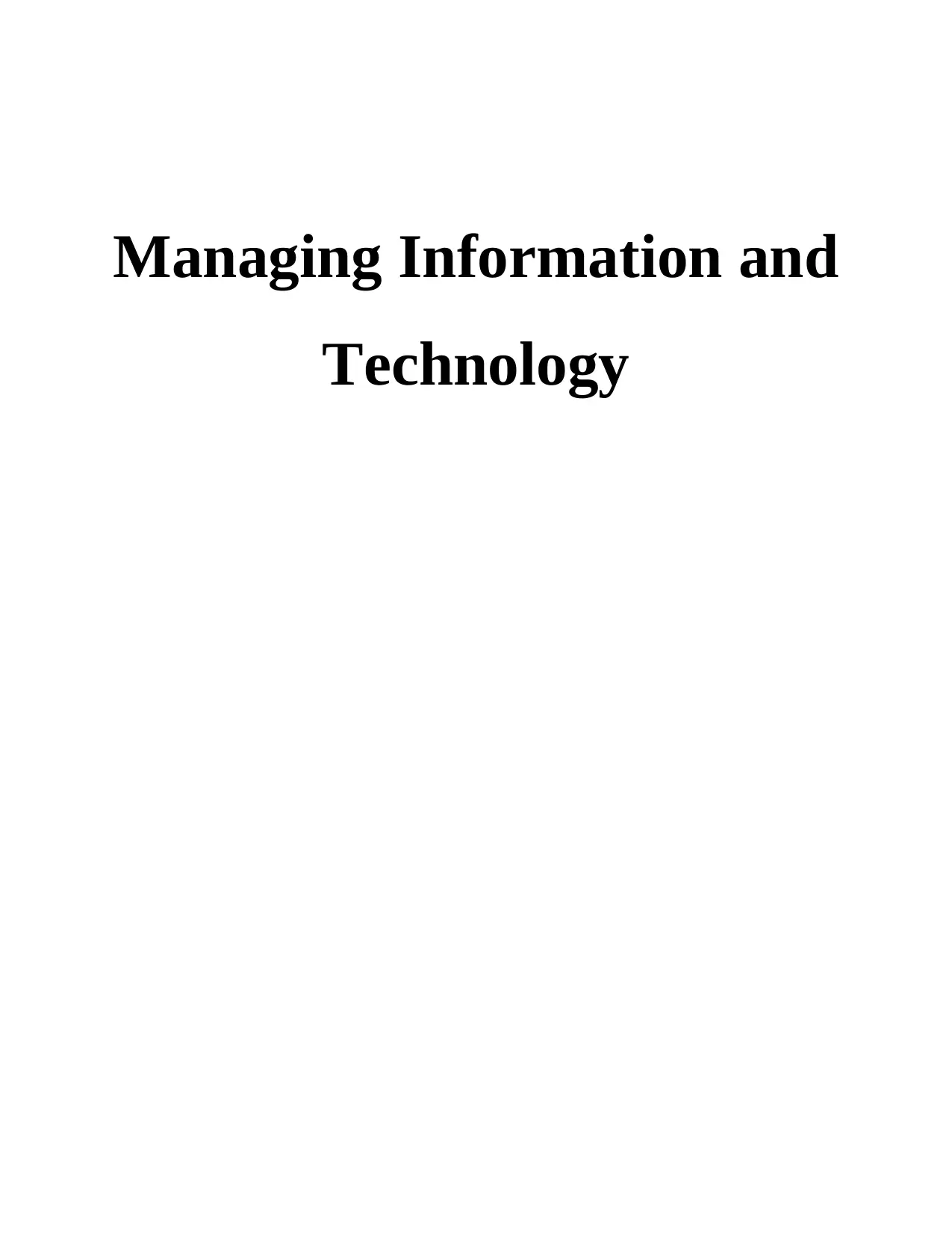
Managing Information and
Technology
Technology
Secure Best Marks with AI Grader
Need help grading? Try our AI Grader for instant feedback on your assignments.
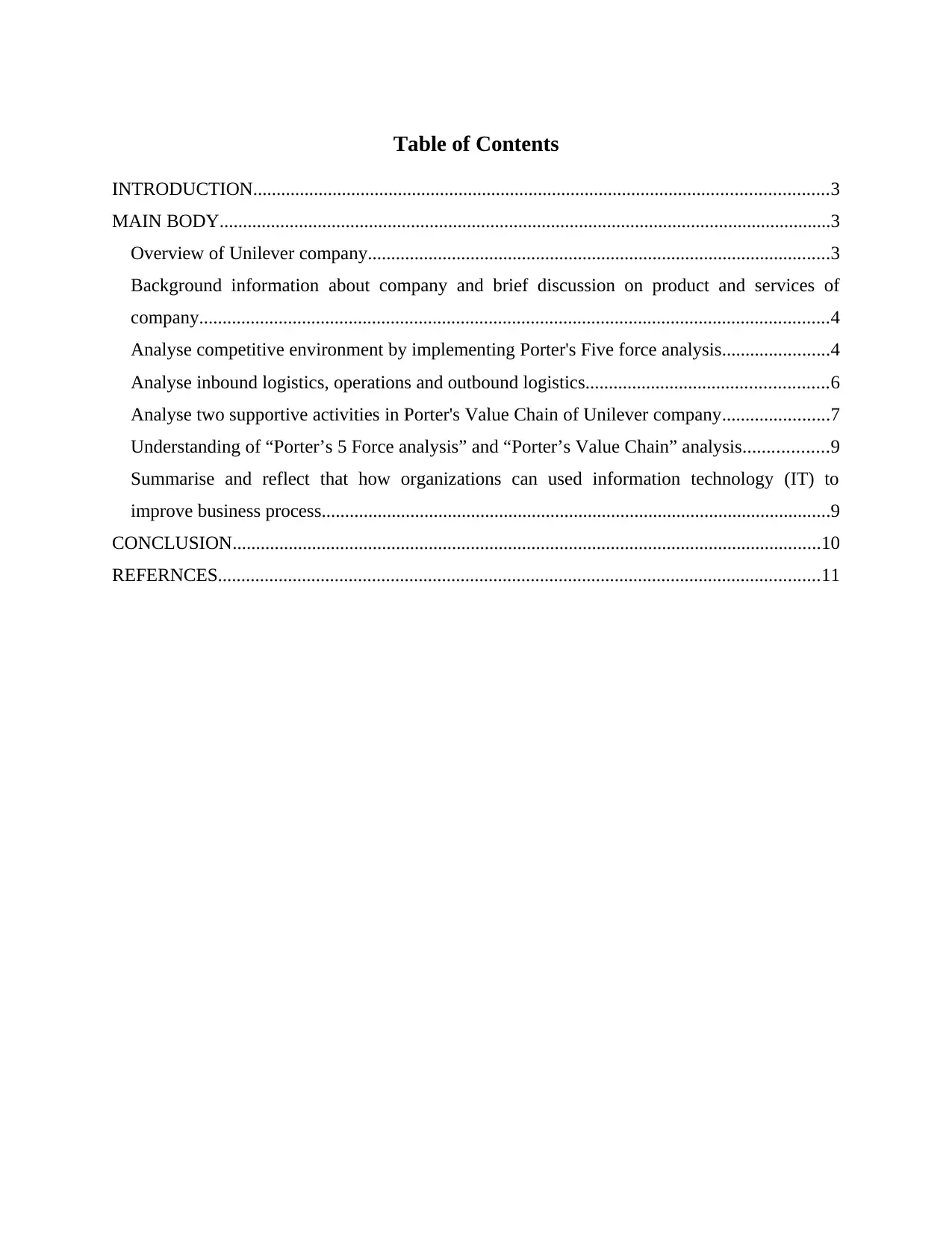
Table of Contents
INTRODUCTION...........................................................................................................................3
MAIN BODY...................................................................................................................................3
Overview of Unilever company...................................................................................................3
Background information about company and brief discussion on product and services of
company.......................................................................................................................................4
Analyse competitive environment by implementing Porter's Five force analysis.......................4
Analyse inbound logistics, operations and outbound logistics....................................................6
Analyse two supportive activities in Porter's Value Chain of Unilever company.......................7
Understanding of “Porter’s 5 Force analysis” and “Porter’s Value Chain” analysis..................9
Summarise and reflect that how organizations can used information technology (IT) to
improve business process.............................................................................................................9
CONCLUSION..............................................................................................................................10
REFERNCES.................................................................................................................................11
INTRODUCTION...........................................................................................................................3
MAIN BODY...................................................................................................................................3
Overview of Unilever company...................................................................................................3
Background information about company and brief discussion on product and services of
company.......................................................................................................................................4
Analyse competitive environment by implementing Porter's Five force analysis.......................4
Analyse inbound logistics, operations and outbound logistics....................................................6
Analyse two supportive activities in Porter's Value Chain of Unilever company.......................7
Understanding of “Porter’s 5 Force analysis” and “Porter’s Value Chain” analysis..................9
Summarise and reflect that how organizations can used information technology (IT) to
improve business process.............................................................................................................9
CONCLUSION..............................................................................................................................10
REFERNCES.................................................................................................................................11
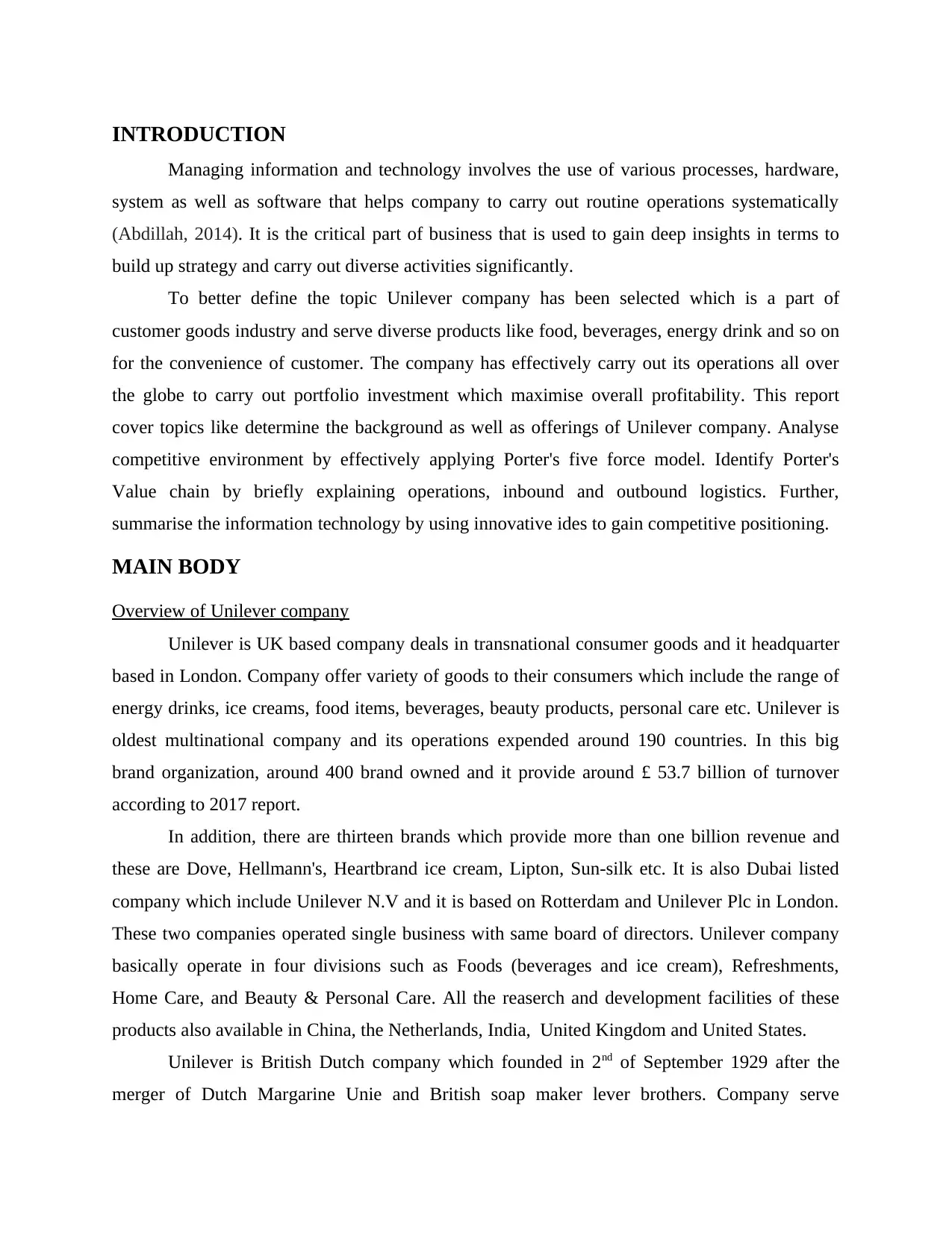
INTRODUCTION
Managing information and technology involves the use of various processes, hardware,
system as well as software that helps company to carry out routine operations systematically
(Abdillah, 2014). It is the critical part of business that is used to gain deep insights in terms to
build up strategy and carry out diverse activities significantly.
To better define the topic Unilever company has been selected which is a part of
customer goods industry and serve diverse products like food, beverages, energy drink and so on
for the convenience of customer. The company has effectively carry out its operations all over
the globe to carry out portfolio investment which maximise overall profitability. This report
cover topics like determine the background as well as offerings of Unilever company. Analyse
competitive environment by effectively applying Porter's five force model. Identify Porter's
Value chain by briefly explaining operations, inbound and outbound logistics. Further,
summarise the information technology by using innovative ides to gain competitive positioning.
MAIN BODY
Overview of Unilever company
Unilever is UK based company deals in transnational consumer goods and it headquarter
based in London. Company offer variety of goods to their consumers which include the range of
energy drinks, ice creams, food items, beverages, beauty products, personal care etc. Unilever is
oldest multinational company and its operations expended around 190 countries. In this big
brand organization, around 400 brand owned and it provide around £ 53.7 billion of turnover
according to 2017 report.
In addition, there are thirteen brands which provide more than one billion revenue and
these are Dove, Hellmann's, Heartbrand ice cream, Lipton, Sun-silk etc. It is also Dubai listed
company which include Unilever N.V and it is based on Rotterdam and Unilever Plc in London.
These two companies operated single business with same board of directors. Unilever company
basically operate in four divisions such as Foods (beverages and ice cream), Refreshments,
Home Care, and Beauty & Personal Care. All the reaserch and development facilities of these
products also available in China, the Netherlands, India, United Kingdom and United States.
Unilever is British Dutch company which founded in 2nd of September 1929 after the
merger of Dutch Margarine Unie and British soap maker lever brothers. Company serve
Managing information and technology involves the use of various processes, hardware,
system as well as software that helps company to carry out routine operations systematically
(Abdillah, 2014). It is the critical part of business that is used to gain deep insights in terms to
build up strategy and carry out diverse activities significantly.
To better define the topic Unilever company has been selected which is a part of
customer goods industry and serve diverse products like food, beverages, energy drink and so on
for the convenience of customer. The company has effectively carry out its operations all over
the globe to carry out portfolio investment which maximise overall profitability. This report
cover topics like determine the background as well as offerings of Unilever company. Analyse
competitive environment by effectively applying Porter's five force model. Identify Porter's
Value chain by briefly explaining operations, inbound and outbound logistics. Further,
summarise the information technology by using innovative ides to gain competitive positioning.
MAIN BODY
Overview of Unilever company
Unilever is UK based company deals in transnational consumer goods and it headquarter
based in London. Company offer variety of goods to their consumers which include the range of
energy drinks, ice creams, food items, beverages, beauty products, personal care etc. Unilever is
oldest multinational company and its operations expended around 190 countries. In this big
brand organization, around 400 brand owned and it provide around £ 53.7 billion of turnover
according to 2017 report.
In addition, there are thirteen brands which provide more than one billion revenue and
these are Dove, Hellmann's, Heartbrand ice cream, Lipton, Sun-silk etc. It is also Dubai listed
company which include Unilever N.V and it is based on Rotterdam and Unilever Plc in London.
These two companies operated single business with same board of directors. Unilever company
basically operate in four divisions such as Foods (beverages and ice cream), Refreshments,
Home Care, and Beauty & Personal Care. All the reaserch and development facilities of these
products also available in China, the Netherlands, India, United Kingdom and United States.
Unilever is British Dutch company which founded in 2nd of September 1929 after the
merger of Dutch Margarine Unie and British soap maker lever brothers. Company serve
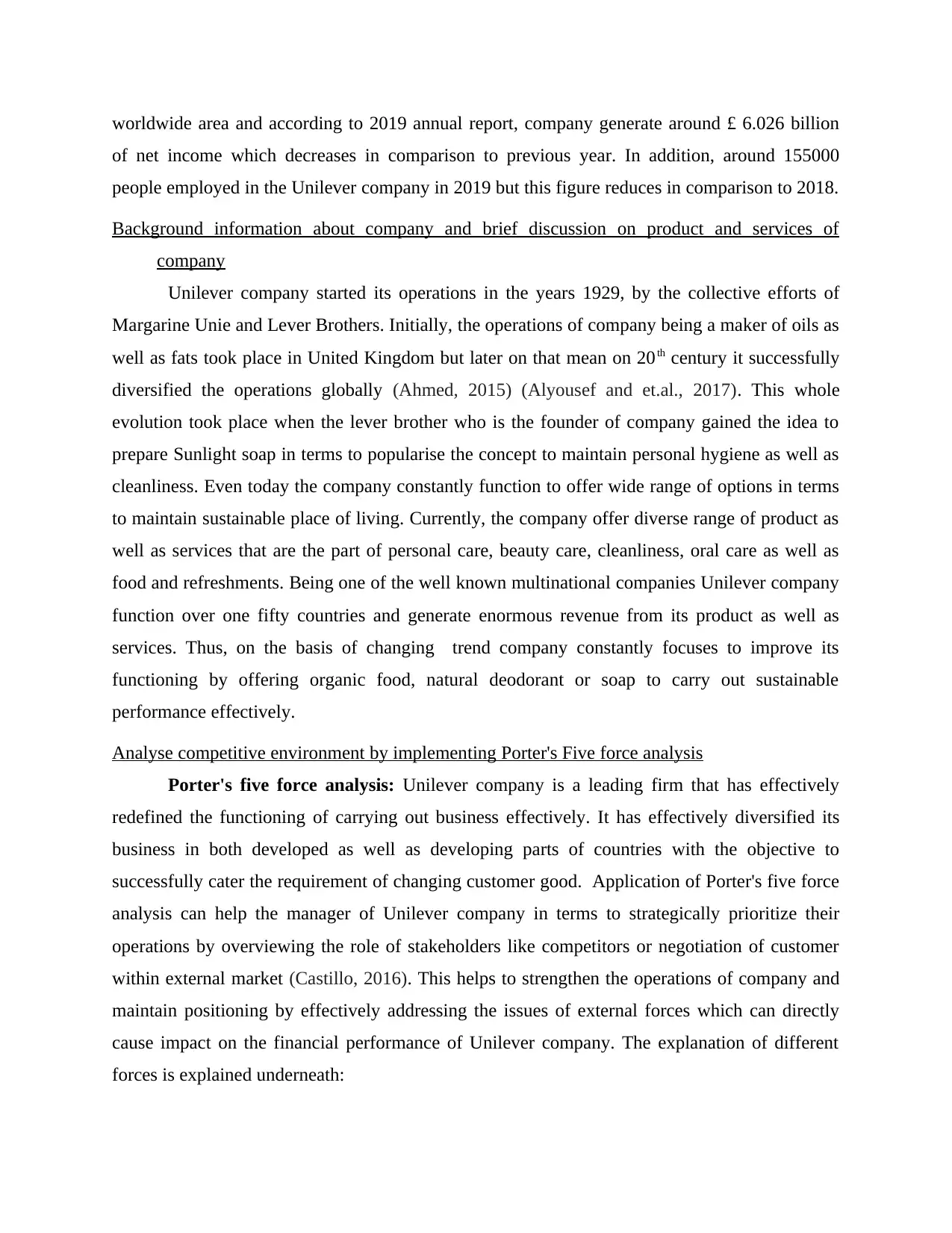
worldwide area and according to 2019 annual report, company generate around £ 6.026 billion
of net income which decreases in comparison to previous year. In addition, around 155000
people employed in the Unilever company in 2019 but this figure reduces in comparison to 2018.
Background information about company and brief discussion on product and services of
company
Unilever company started its operations in the years 1929, by the collective efforts of
Margarine Unie and Lever Brothers. Initially, the operations of company being a maker of oils as
well as fats took place in United Kingdom but later on that mean on 20th century it successfully
diversified the operations globally (Ahmed, 2015) (Alyousef and et.al., 2017). This whole
evolution took place when the lever brother who is the founder of company gained the idea to
prepare Sunlight soap in terms to popularise the concept to maintain personal hygiene as well as
cleanliness. Even today the company constantly function to offer wide range of options in terms
to maintain sustainable place of living. Currently, the company offer diverse range of product as
well as services that are the part of personal care, beauty care, cleanliness, oral care as well as
food and refreshments. Being one of the well known multinational companies Unilever company
function over one fifty countries and generate enormous revenue from its product as well as
services. Thus, on the basis of changing trend company constantly focuses to improve its
functioning by offering organic food, natural deodorant or soap to carry out sustainable
performance effectively.
Analyse competitive environment by implementing Porter's Five force analysis
Porter's five force analysis: Unilever company is a leading firm that has effectively
redefined the functioning of carrying out business effectively. It has effectively diversified its
business in both developed as well as developing parts of countries with the objective to
successfully cater the requirement of changing customer good. Application of Porter's five force
analysis can help the manager of Unilever company in terms to strategically prioritize their
operations by overviewing the role of stakeholders like competitors or negotiation of customer
within external market (Castillo, 2016). This helps to strengthen the operations of company and
maintain positioning by effectively addressing the issues of external forces which can directly
cause impact on the financial performance of Unilever company. The explanation of different
forces is explained underneath:
of net income which decreases in comparison to previous year. In addition, around 155000
people employed in the Unilever company in 2019 but this figure reduces in comparison to 2018.
Background information about company and brief discussion on product and services of
company
Unilever company started its operations in the years 1929, by the collective efforts of
Margarine Unie and Lever Brothers. Initially, the operations of company being a maker of oils as
well as fats took place in United Kingdom but later on that mean on 20th century it successfully
diversified the operations globally (Ahmed, 2015) (Alyousef and et.al., 2017). This whole
evolution took place when the lever brother who is the founder of company gained the idea to
prepare Sunlight soap in terms to popularise the concept to maintain personal hygiene as well as
cleanliness. Even today the company constantly function to offer wide range of options in terms
to maintain sustainable place of living. Currently, the company offer diverse range of product as
well as services that are the part of personal care, beauty care, cleanliness, oral care as well as
food and refreshments. Being one of the well known multinational companies Unilever company
function over one fifty countries and generate enormous revenue from its product as well as
services. Thus, on the basis of changing trend company constantly focuses to improve its
functioning by offering organic food, natural deodorant or soap to carry out sustainable
performance effectively.
Analyse competitive environment by implementing Porter's Five force analysis
Porter's five force analysis: Unilever company is a leading firm that has effectively
redefined the functioning of carrying out business effectively. It has effectively diversified its
business in both developed as well as developing parts of countries with the objective to
successfully cater the requirement of changing customer good. Application of Porter's five force
analysis can help the manager of Unilever company in terms to strategically prioritize their
operations by overviewing the role of stakeholders like competitors or negotiation of customer
within external market (Castillo, 2016). This helps to strengthen the operations of company and
maintain positioning by effectively addressing the issues of external forces which can directly
cause impact on the financial performance of Unilever company. The explanation of different
forces is explained underneath:
Secure Best Marks with AI Grader
Need help grading? Try our AI Grader for instant feedback on your assignments.
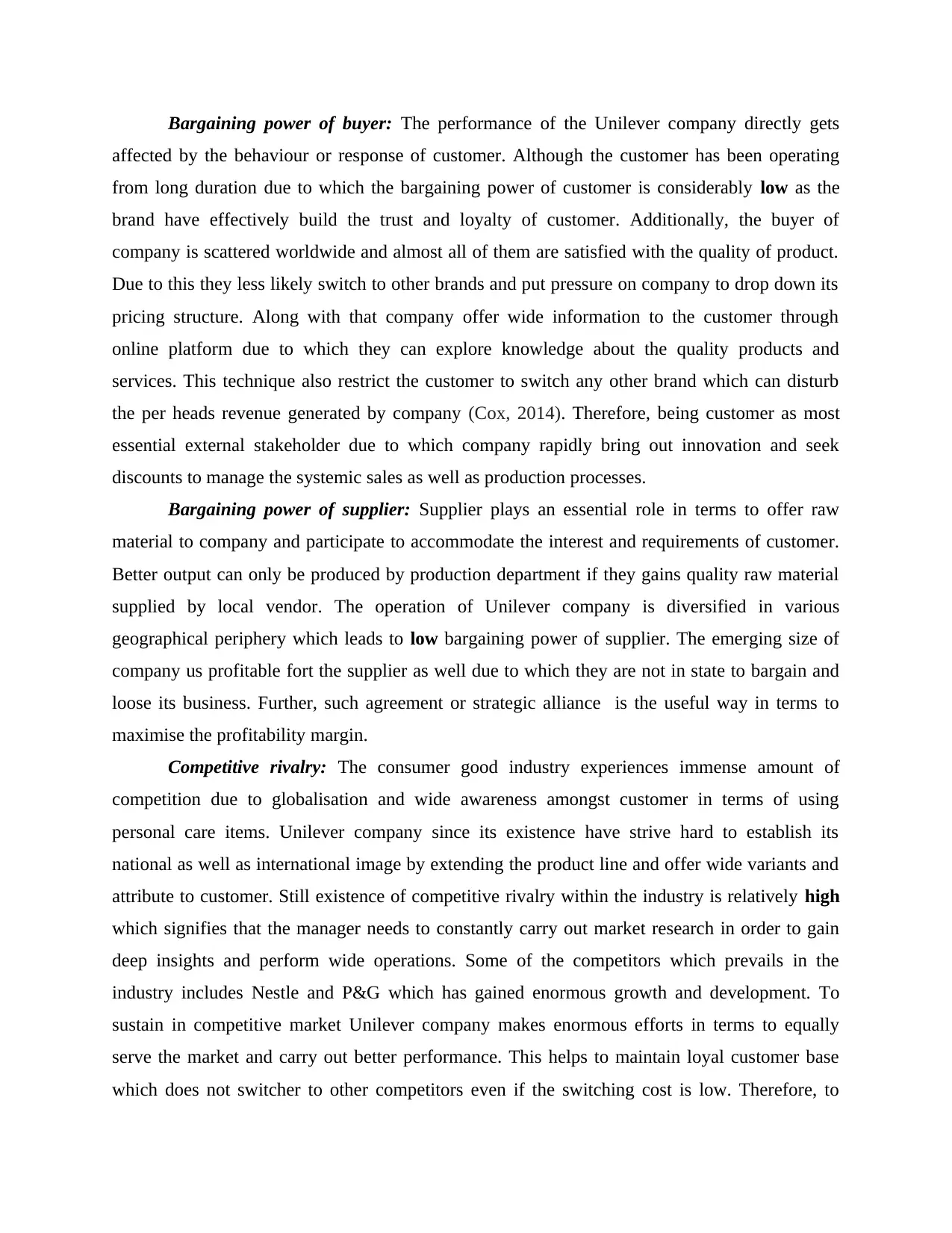
Bargaining power of buyer: The performance of the Unilever company directly gets
affected by the behaviour or response of customer. Although the customer has been operating
from long duration due to which the bargaining power of customer is considerably low as the
brand have effectively build the trust and loyalty of customer. Additionally, the buyer of
company is scattered worldwide and almost all of them are satisfied with the quality of product.
Due to this they less likely switch to other brands and put pressure on company to drop down its
pricing structure. Along with that company offer wide information to the customer through
online platform due to which they can explore knowledge about the quality products and
services. This technique also restrict the customer to switch any other brand which can disturb
the per heads revenue generated by company (Cox, 2014). Therefore, being customer as most
essential external stakeholder due to which company rapidly bring out innovation and seek
discounts to manage the systemic sales as well as production processes.
Bargaining power of supplier: Supplier plays an essential role in terms to offer raw
material to company and participate to accommodate the interest and requirements of customer.
Better output can only be produced by production department if they gains quality raw material
supplied by local vendor. The operation of Unilever company is diversified in various
geographical periphery which leads to low bargaining power of supplier. The emerging size of
company us profitable fort the supplier as well due to which they are not in state to bargain and
loose its business. Further, such agreement or strategic alliance is the useful way in terms to
maximise the profitability margin.
Competitive rivalry: The consumer good industry experiences immense amount of
competition due to globalisation and wide awareness amongst customer in terms of using
personal care items. Unilever company since its existence have strive hard to establish its
national as well as international image by extending the product line and offer wide variants and
attribute to customer. Still existence of competitive rivalry within the industry is relatively high
which signifies that the manager needs to constantly carry out market research in order to gain
deep insights and perform wide operations. Some of the competitors which prevails in the
industry includes Nestle and P&G which has gained enormous growth and development. To
sustain in competitive market Unilever company makes enormous efforts in terms to equally
serve the market and carry out better performance. This helps to maintain loyal customer base
which does not switcher to other competitors even if the switching cost is low. Therefore, to
affected by the behaviour or response of customer. Although the customer has been operating
from long duration due to which the bargaining power of customer is considerably low as the
brand have effectively build the trust and loyalty of customer. Additionally, the buyer of
company is scattered worldwide and almost all of them are satisfied with the quality of product.
Due to this they less likely switch to other brands and put pressure on company to drop down its
pricing structure. Along with that company offer wide information to the customer through
online platform due to which they can explore knowledge about the quality products and
services. This technique also restrict the customer to switch any other brand which can disturb
the per heads revenue generated by company (Cox, 2014). Therefore, being customer as most
essential external stakeholder due to which company rapidly bring out innovation and seek
discounts to manage the systemic sales as well as production processes.
Bargaining power of supplier: Supplier plays an essential role in terms to offer raw
material to company and participate to accommodate the interest and requirements of customer.
Better output can only be produced by production department if they gains quality raw material
supplied by local vendor. The operation of Unilever company is diversified in various
geographical periphery which leads to low bargaining power of supplier. The emerging size of
company us profitable fort the supplier as well due to which they are not in state to bargain and
loose its business. Further, such agreement or strategic alliance is the useful way in terms to
maximise the profitability margin.
Competitive rivalry: The consumer good industry experiences immense amount of
competition due to globalisation and wide awareness amongst customer in terms of using
personal care items. Unilever company since its existence have strive hard to establish its
national as well as international image by extending the product line and offer wide variants and
attribute to customer. Still existence of competitive rivalry within the industry is relatively high
which signifies that the manager needs to constantly carry out market research in order to gain
deep insights and perform wide operations. Some of the competitors which prevails in the
industry includes Nestle and P&G which has gained enormous growth and development. To
sustain in competitive market Unilever company makes enormous efforts in terms to equally
serve the market and carry out better performance. This helps to maintain loyal customer base
which does not switcher to other competitors even if the switching cost is low. Therefore, to
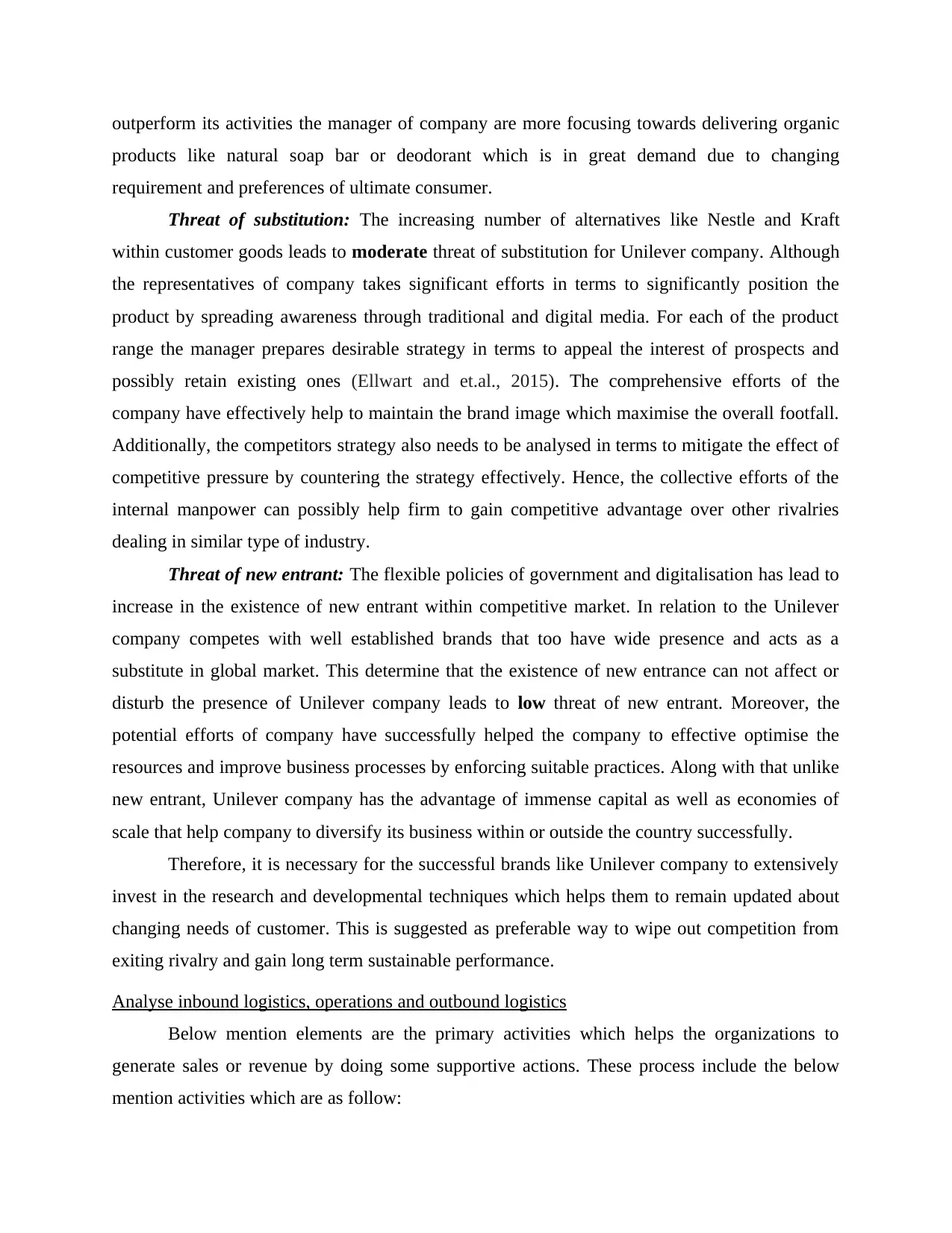
outperform its activities the manager of company are more focusing towards delivering organic
products like natural soap bar or deodorant which is in great demand due to changing
requirement and preferences of ultimate consumer.
Threat of substitution: The increasing number of alternatives like Nestle and Kraft
within customer goods leads to moderate threat of substitution for Unilever company. Although
the representatives of company takes significant efforts in terms to significantly position the
product by spreading awareness through traditional and digital media. For each of the product
range the manager prepares desirable strategy in terms to appeal the interest of prospects and
possibly retain existing ones (Ellwart and et.al., 2015). The comprehensive efforts of the
company have effectively help to maintain the brand image which maximise the overall footfall.
Additionally, the competitors strategy also needs to be analysed in terms to mitigate the effect of
competitive pressure by countering the strategy effectively. Hence, the collective efforts of the
internal manpower can possibly help firm to gain competitive advantage over other rivalries
dealing in similar type of industry.
Threat of new entrant: The flexible policies of government and digitalisation has lead to
increase in the existence of new entrant within competitive market. In relation to the Unilever
company competes with well established brands that too have wide presence and acts as a
substitute in global market. This determine that the existence of new entrance can not affect or
disturb the presence of Unilever company leads to low threat of new entrant. Moreover, the
potential efforts of company have successfully helped the company to effective optimise the
resources and improve business processes by enforcing suitable practices. Along with that unlike
new entrant, Unilever company has the advantage of immense capital as well as economies of
scale that help company to diversify its business within or outside the country successfully.
Therefore, it is necessary for the successful brands like Unilever company to extensively
invest in the research and developmental techniques which helps them to remain updated about
changing needs of customer. This is suggested as preferable way to wipe out competition from
exiting rivalry and gain long term sustainable performance.
Analyse inbound logistics, operations and outbound logistics
Below mention elements are the primary activities which helps the organizations to
generate sales or revenue by doing some supportive actions. These process include the below
mention activities which are as follow:
products like natural soap bar or deodorant which is in great demand due to changing
requirement and preferences of ultimate consumer.
Threat of substitution: The increasing number of alternatives like Nestle and Kraft
within customer goods leads to moderate threat of substitution for Unilever company. Although
the representatives of company takes significant efforts in terms to significantly position the
product by spreading awareness through traditional and digital media. For each of the product
range the manager prepares desirable strategy in terms to appeal the interest of prospects and
possibly retain existing ones (Ellwart and et.al., 2015). The comprehensive efforts of the
company have effectively help to maintain the brand image which maximise the overall footfall.
Additionally, the competitors strategy also needs to be analysed in terms to mitigate the effect of
competitive pressure by countering the strategy effectively. Hence, the collective efforts of the
internal manpower can possibly help firm to gain competitive advantage over other rivalries
dealing in similar type of industry.
Threat of new entrant: The flexible policies of government and digitalisation has lead to
increase in the existence of new entrant within competitive market. In relation to the Unilever
company competes with well established brands that too have wide presence and acts as a
substitute in global market. This determine that the existence of new entrance can not affect or
disturb the presence of Unilever company leads to low threat of new entrant. Moreover, the
potential efforts of company have successfully helped the company to effective optimise the
resources and improve business processes by enforcing suitable practices. Along with that unlike
new entrant, Unilever company has the advantage of immense capital as well as economies of
scale that help company to diversify its business within or outside the country successfully.
Therefore, it is necessary for the successful brands like Unilever company to extensively
invest in the research and developmental techniques which helps them to remain updated about
changing needs of customer. This is suggested as preferable way to wipe out competition from
exiting rivalry and gain long term sustainable performance.
Analyse inbound logistics, operations and outbound logistics
Below mention elements are the primary activities which helps the organizations to
generate sales or revenue by doing some supportive actions. These process include the below
mention activities which are as follow:
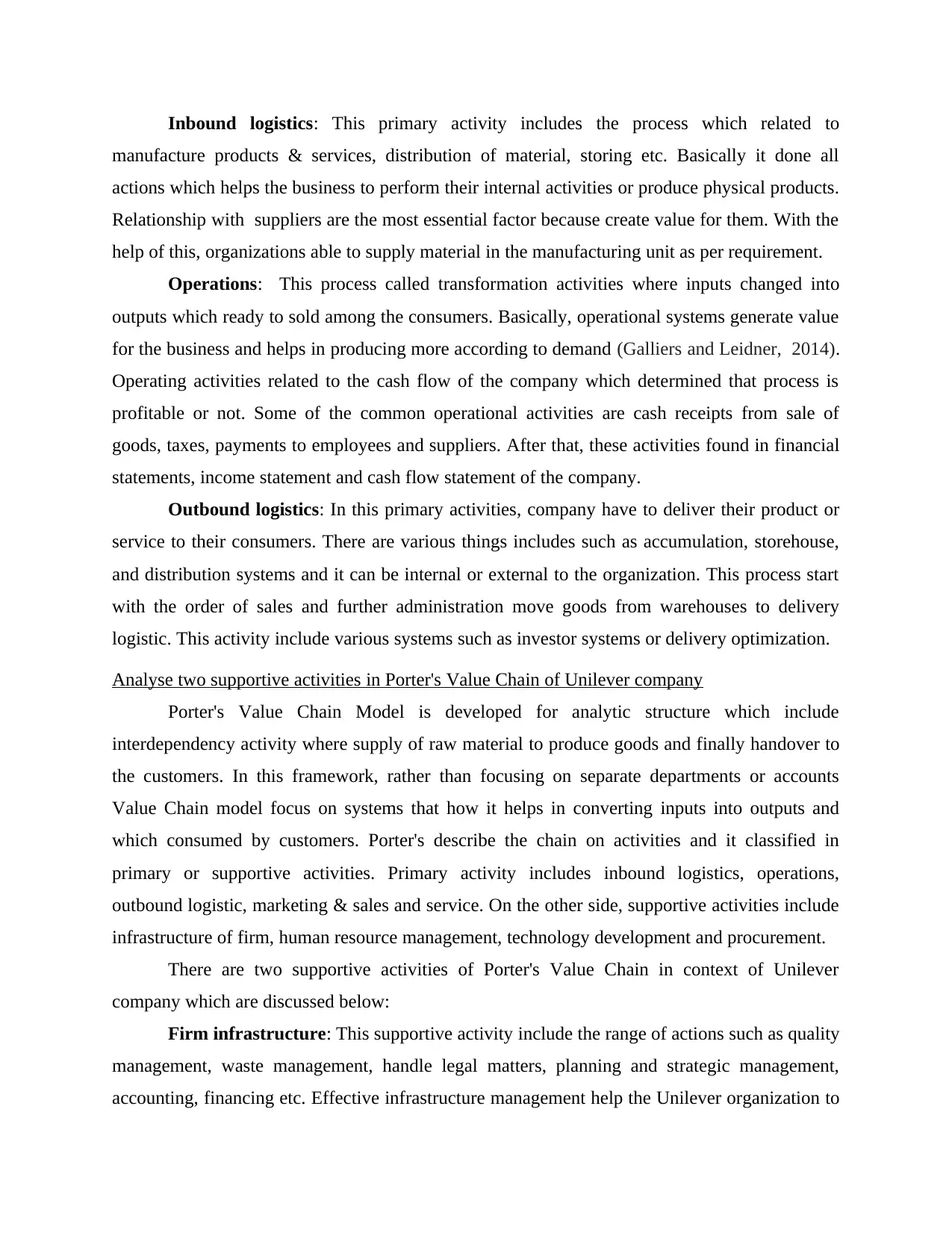
Inbound logistics: This primary activity includes the process which related to
manufacture products & services, distribution of material, storing etc. Basically it done all
actions which helps the business to perform their internal activities or produce physical products.
Relationship with suppliers are the most essential factor because create value for them. With the
help of this, organizations able to supply material in the manufacturing unit as per requirement.
Operations: This process called transformation activities where inputs changed into
outputs which ready to sold among the consumers. Basically, operational systems generate value
for the business and helps in producing more according to demand (Galliers and Leidner, 2014).
Operating activities related to the cash flow of the company which determined that process is
profitable or not. Some of the common operational activities are cash receipts from sale of
goods, taxes, payments to employees and suppliers. After that, these activities found in financial
statements, income statement and cash flow statement of the company.
Outbound logistics: In this primary activities, company have to deliver their product or
service to their consumers. There are various things includes such as accumulation, storehouse,
and distribution systems and it can be internal or external to the organization. This process start
with the order of sales and further administration move goods from warehouses to delivery
logistic. This activity include various systems such as investor systems or delivery optimization.
Analyse two supportive activities in Porter's Value Chain of Unilever company
Porter's Value Chain Model is developed for analytic structure which include
interdependency activity where supply of raw material to produce goods and finally handover to
the customers. In this framework, rather than focusing on separate departments or accounts
Value Chain model focus on systems that how it helps in converting inputs into outputs and
which consumed by customers. Porter's describe the chain on activities and it classified in
primary or supportive activities. Primary activity includes inbound logistics, operations,
outbound logistic, marketing & sales and service. On the other side, supportive activities include
infrastructure of firm, human resource management, technology development and procurement.
There are two supportive activities of Porter's Value Chain in context of Unilever
company which are discussed below:
Firm infrastructure: This supportive activity include the range of actions such as quality
management, waste management, handle legal matters, planning and strategic management,
accounting, financing etc. Effective infrastructure management help the Unilever organization to
manufacture products & services, distribution of material, storing etc. Basically it done all
actions which helps the business to perform their internal activities or produce physical products.
Relationship with suppliers are the most essential factor because create value for them. With the
help of this, organizations able to supply material in the manufacturing unit as per requirement.
Operations: This process called transformation activities where inputs changed into
outputs which ready to sold among the consumers. Basically, operational systems generate value
for the business and helps in producing more according to demand (Galliers and Leidner, 2014).
Operating activities related to the cash flow of the company which determined that process is
profitable or not. Some of the common operational activities are cash receipts from sale of
goods, taxes, payments to employees and suppliers. After that, these activities found in financial
statements, income statement and cash flow statement of the company.
Outbound logistics: In this primary activities, company have to deliver their product or
service to their consumers. There are various things includes such as accumulation, storehouse,
and distribution systems and it can be internal or external to the organization. This process start
with the order of sales and further administration move goods from warehouses to delivery
logistic. This activity include various systems such as investor systems or delivery optimization.
Analyse two supportive activities in Porter's Value Chain of Unilever company
Porter's Value Chain Model is developed for analytic structure which include
interdependency activity where supply of raw material to produce goods and finally handover to
the customers. In this framework, rather than focusing on separate departments or accounts
Value Chain model focus on systems that how it helps in converting inputs into outputs and
which consumed by customers. Porter's describe the chain on activities and it classified in
primary or supportive activities. Primary activity includes inbound logistics, operations,
outbound logistic, marketing & sales and service. On the other side, supportive activities include
infrastructure of firm, human resource management, technology development and procurement.
There are two supportive activities of Porter's Value Chain in context of Unilever
company which are discussed below:
Firm infrastructure: This supportive activity include the range of actions such as quality
management, waste management, handle legal matters, planning and strategic management,
accounting, financing etc. Effective infrastructure management help the Unilever organization to
Paraphrase This Document
Need a fresh take? Get an instant paraphrase of this document with our AI Paraphraser
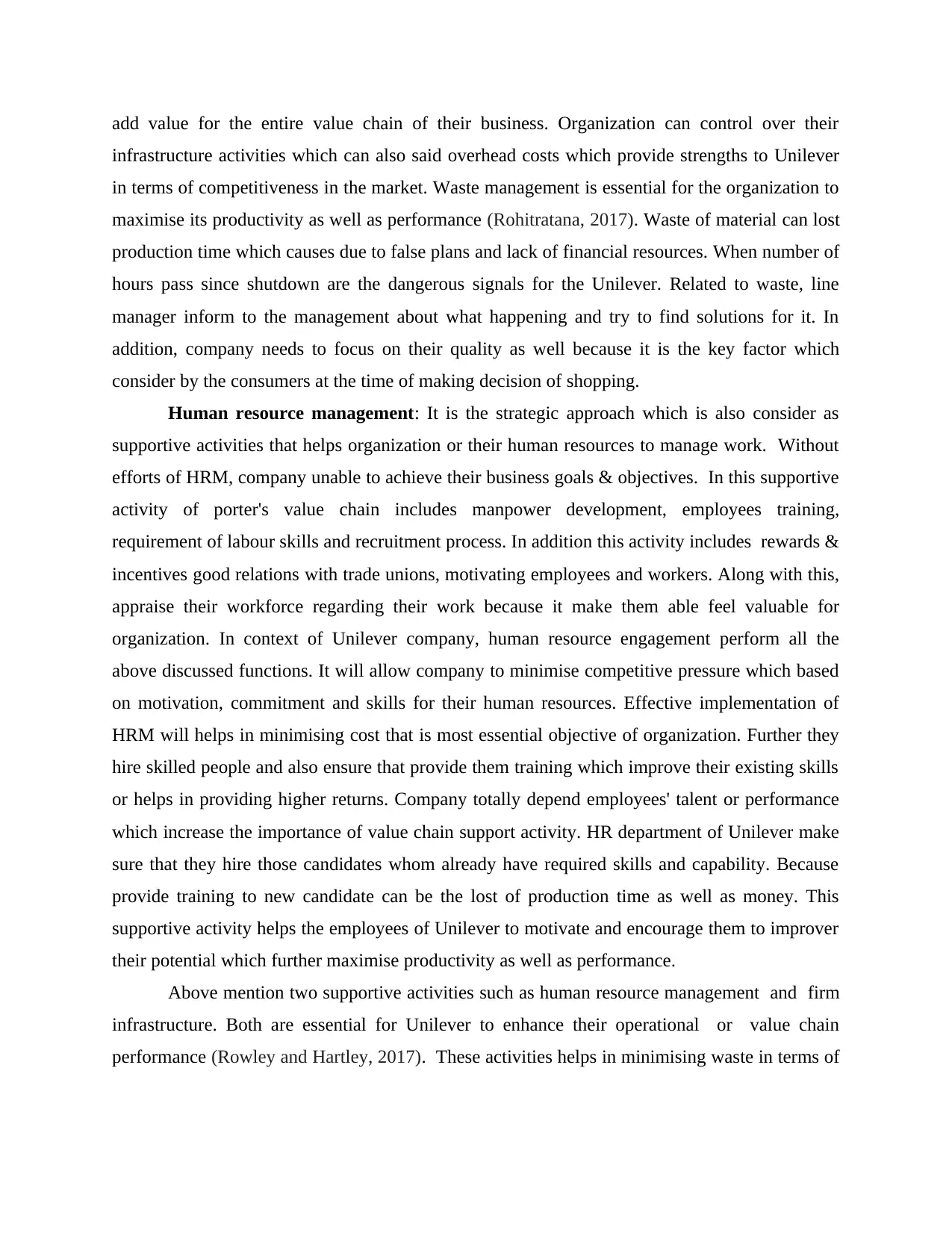
add value for the entire value chain of their business. Organization can control over their
infrastructure activities which can also said overhead costs which provide strengths to Unilever
in terms of competitiveness in the market. Waste management is essential for the organization to
maximise its productivity as well as performance (Rohitratana, 2017). Waste of material can lost
production time which causes due to false plans and lack of financial resources. When number of
hours pass since shutdown are the dangerous signals for the Unilever. Related to waste, line
manager inform to the management about what happening and try to find solutions for it. In
addition, company needs to focus on their quality as well because it is the key factor which
consider by the consumers at the time of making decision of shopping.
Human resource management: It is the strategic approach which is also consider as
supportive activities that helps organization or their human resources to manage work. Without
efforts of HRM, company unable to achieve their business goals & objectives. In this supportive
activity of porter's value chain includes manpower development, employees training,
requirement of labour skills and recruitment process. In addition this activity includes rewards &
incentives good relations with trade unions, motivating employees and workers. Along with this,
appraise their workforce regarding their work because it make them able feel valuable for
organization. In context of Unilever company, human resource engagement perform all the
above discussed functions. It will allow company to minimise competitive pressure which based
on motivation, commitment and skills for their human resources. Effective implementation of
HRM will helps in minimising cost that is most essential objective of organization. Further they
hire skilled people and also ensure that provide them training which improve their existing skills
or helps in providing higher returns. Company totally depend employees' talent or performance
which increase the importance of value chain support activity. HR department of Unilever make
sure that they hire those candidates whom already have required skills and capability. Because
provide training to new candidate can be the lost of production time as well as money. This
supportive activity helps the employees of Unilever to motivate and encourage them to improver
their potential which further maximise productivity as well as performance.
Above mention two supportive activities such as human resource management and firm
infrastructure. Both are essential for Unilever to enhance their operational or value chain
performance (Rowley and Hartley, 2017). These activities helps in minimising waste in terms of
infrastructure activities which can also said overhead costs which provide strengths to Unilever
in terms of competitiveness in the market. Waste management is essential for the organization to
maximise its productivity as well as performance (Rohitratana, 2017). Waste of material can lost
production time which causes due to false plans and lack of financial resources. When number of
hours pass since shutdown are the dangerous signals for the Unilever. Related to waste, line
manager inform to the management about what happening and try to find solutions for it. In
addition, company needs to focus on their quality as well because it is the key factor which
consider by the consumers at the time of making decision of shopping.
Human resource management: It is the strategic approach which is also consider as
supportive activities that helps organization or their human resources to manage work. Without
efforts of HRM, company unable to achieve their business goals & objectives. In this supportive
activity of porter's value chain includes manpower development, employees training,
requirement of labour skills and recruitment process. In addition this activity includes rewards &
incentives good relations with trade unions, motivating employees and workers. Along with this,
appraise their workforce regarding their work because it make them able feel valuable for
organization. In context of Unilever company, human resource engagement perform all the
above discussed functions. It will allow company to minimise competitive pressure which based
on motivation, commitment and skills for their human resources. Effective implementation of
HRM will helps in minimising cost that is most essential objective of organization. Further they
hire skilled people and also ensure that provide them training which improve their existing skills
or helps in providing higher returns. Company totally depend employees' talent or performance
which increase the importance of value chain support activity. HR department of Unilever make
sure that they hire those candidates whom already have required skills and capability. Because
provide training to new candidate can be the lost of production time as well as money. This
supportive activity helps the employees of Unilever to motivate and encourage them to improver
their potential which further maximise productivity as well as performance.
Above mention two supportive activities such as human resource management and firm
infrastructure. Both are essential for Unilever to enhance their operational or value chain
performance (Rowley and Hartley, 2017). These activities helps in minimising waste in terms of
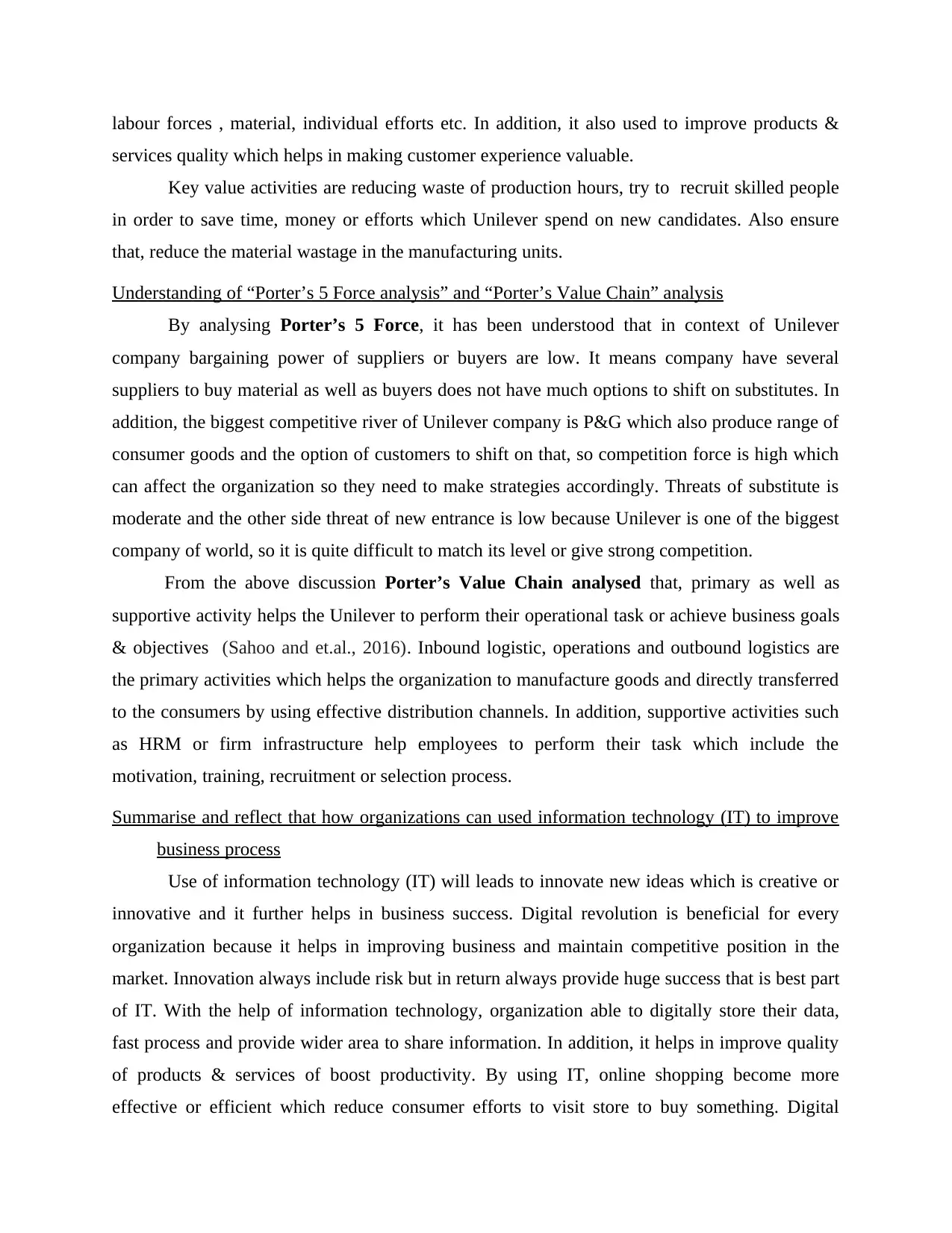
labour forces , material, individual efforts etc. In addition, it also used to improve products &
services quality which helps in making customer experience valuable.
Key value activities are reducing waste of production hours, try to recruit skilled people
in order to save time, money or efforts which Unilever spend on new candidates. Also ensure
that, reduce the material wastage in the manufacturing units.
Understanding of “Porter’s 5 Force analysis” and “Porter’s Value Chain” analysis
By analysing Porter’s 5 Force, it has been understood that in context of Unilever
company bargaining power of suppliers or buyers are low. It means company have several
suppliers to buy material as well as buyers does not have much options to shift on substitutes. In
addition, the biggest competitive river of Unilever company is P&G which also produce range of
consumer goods and the option of customers to shift on that, so competition force is high which
can affect the organization so they need to make strategies accordingly. Threats of substitute is
moderate and the other side threat of new entrance is low because Unilever is one of the biggest
company of world, so it is quite difficult to match its level or give strong competition.
From the above discussion Porter’s Value Chain analysed that, primary as well as
supportive activity helps the Unilever to perform their operational task or achieve business goals
& objectives (Sahoo and et.al., 2016). Inbound logistic, operations and outbound logistics are
the primary activities which helps the organization to manufacture goods and directly transferred
to the consumers by using effective distribution channels. In addition, supportive activities such
as HRM or firm infrastructure help employees to perform their task which include the
motivation, training, recruitment or selection process.
Summarise and reflect that how organizations can used information technology (IT) to improve
business process
Use of information technology (IT) will leads to innovate new ideas which is creative or
innovative and it further helps in business success. Digital revolution is beneficial for every
organization because it helps in improving business and maintain competitive position in the
market. Innovation always include risk but in return always provide huge success that is best part
of IT. With the help of information technology, organization able to digitally store their data,
fast process and provide wider area to share information. In addition, it helps in improve quality
of products & services of boost productivity. By using IT, online shopping become more
effective or efficient which reduce consumer efforts to visit store to buy something. Digital
services quality which helps in making customer experience valuable.
Key value activities are reducing waste of production hours, try to recruit skilled people
in order to save time, money or efforts which Unilever spend on new candidates. Also ensure
that, reduce the material wastage in the manufacturing units.
Understanding of “Porter’s 5 Force analysis” and “Porter’s Value Chain” analysis
By analysing Porter’s 5 Force, it has been understood that in context of Unilever
company bargaining power of suppliers or buyers are low. It means company have several
suppliers to buy material as well as buyers does not have much options to shift on substitutes. In
addition, the biggest competitive river of Unilever company is P&G which also produce range of
consumer goods and the option of customers to shift on that, so competition force is high which
can affect the organization so they need to make strategies accordingly. Threats of substitute is
moderate and the other side threat of new entrance is low because Unilever is one of the biggest
company of world, so it is quite difficult to match its level or give strong competition.
From the above discussion Porter’s Value Chain analysed that, primary as well as
supportive activity helps the Unilever to perform their operational task or achieve business goals
& objectives (Sahoo and et.al., 2016). Inbound logistic, operations and outbound logistics are
the primary activities which helps the organization to manufacture goods and directly transferred
to the consumers by using effective distribution channels. In addition, supportive activities such
as HRM or firm infrastructure help employees to perform their task which include the
motivation, training, recruitment or selection process.
Summarise and reflect that how organizations can used information technology (IT) to improve
business process
Use of information technology (IT) will leads to innovate new ideas which is creative or
innovative and it further helps in business success. Digital revolution is beneficial for every
organization because it helps in improving business and maintain competitive position in the
market. Innovation always include risk but in return always provide huge success that is best part
of IT. With the help of information technology, organization able to digitally store their data,
fast process and provide wider area to share information. In addition, it helps in improve quality
of products & services of boost productivity. By using IT, online shopping become more
effective or efficient which reduce consumer efforts to visit store to buy something. Digital
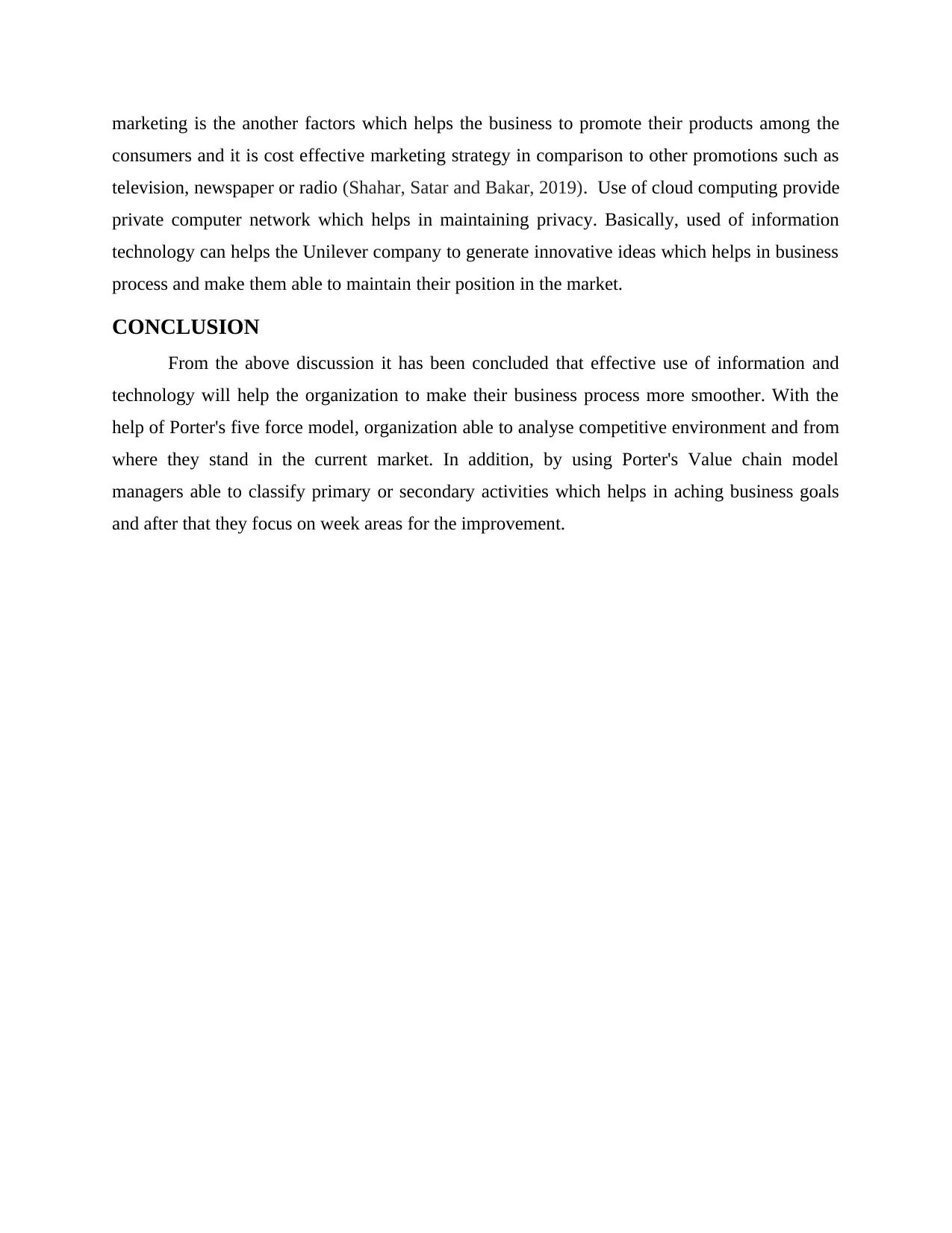
marketing is the another factors which helps the business to promote their products among the
consumers and it is cost effective marketing strategy in comparison to other promotions such as
television, newspaper or radio (Shahar, Satar and Bakar, 2019). Use of cloud computing provide
private computer network which helps in maintaining privacy. Basically, used of information
technology can helps the Unilever company to generate innovative ideas which helps in business
process and make them able to maintain their position in the market.
CONCLUSION
From the above discussion it has been concluded that effective use of information and
technology will help the organization to make their business process more smoother. With the
help of Porter's five force model, organization able to analyse competitive environment and from
where they stand in the current market. In addition, by using Porter's Value chain model
managers able to classify primary or secondary activities which helps in aching business goals
and after that they focus on week areas for the improvement.
consumers and it is cost effective marketing strategy in comparison to other promotions such as
television, newspaper or radio (Shahar, Satar and Bakar, 2019). Use of cloud computing provide
private computer network which helps in maintaining privacy. Basically, used of information
technology can helps the Unilever company to generate innovative ideas which helps in business
process and make them able to maintain their position in the market.
CONCLUSION
From the above discussion it has been concluded that effective use of information and
technology will help the organization to make their business process more smoother. With the
help of Porter's five force model, organization able to analyse competitive environment and from
where they stand in the current market. In addition, by using Porter's Value chain model
managers able to classify primary or secondary activities which helps in aching business goals
and after that they focus on week areas for the improvement.
Secure Best Marks with AI Grader
Need help grading? Try our AI Grader for instant feedback on your assignments.
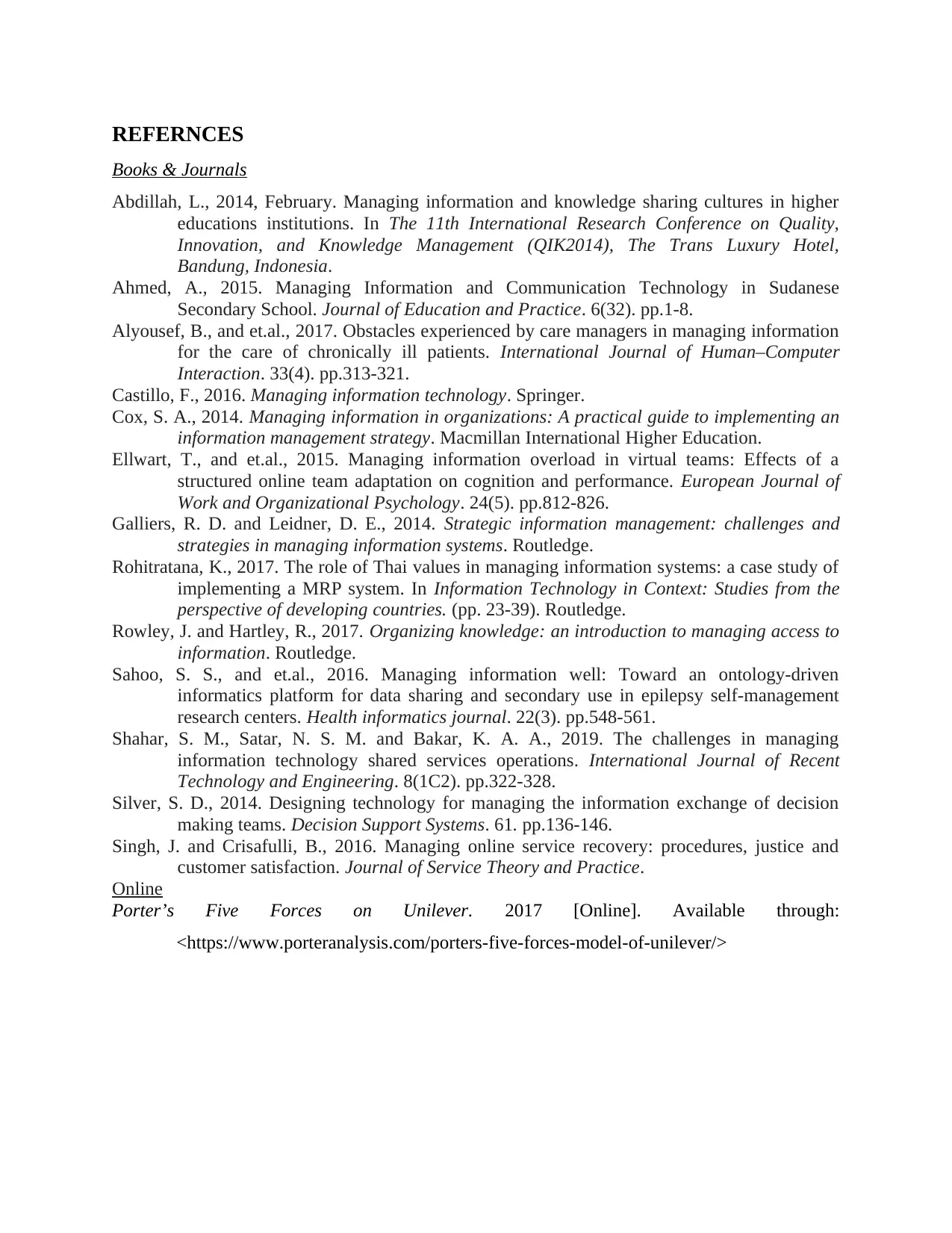
REFERNCES
Books & Journals
Abdillah, L., 2014, February. Managing information and knowledge sharing cultures in higher
educations institutions. In The 11th International Research Conference on Quality,
Innovation, and Knowledge Management (QIK2014), The Trans Luxury Hotel,
Bandung, Indonesia.
Ahmed, A., 2015. Managing Information and Communication Technology in Sudanese
Secondary School. Journal of Education and Practice. 6(32). pp.1-8.
Alyousef, B., and et.al., 2017. Obstacles experienced by care managers in managing information
for the care of chronically ill patients. International Journal of Human–Computer
Interaction. 33(4). pp.313-321.
Castillo, F., 2016. Managing information technology. Springer.
Cox, S. A., 2014. Managing information in organizations: A practical guide to implementing an
information management strategy. Macmillan International Higher Education.
Ellwart, T., and et.al., 2015. Managing information overload in virtual teams: Effects of a
structured online team adaptation on cognition and performance. European Journal of
Work and Organizational Psychology. 24(5). pp.812-826.
Galliers, R. D. and Leidner, D. E., 2014. Strategic information management: challenges and
strategies in managing information systems. Routledge.
Rohitratana, K., 2017. The role of Thai values in managing information systems: a case study of
implementing a MRP system. In Information Technology in Context: Studies from the
perspective of developing countries. (pp. 23-39). Routledge.
Rowley, J. and Hartley, R., 2017. Organizing knowledge: an introduction to managing access to
information. Routledge.
Sahoo, S. S., and et.al., 2016. Managing information well: Toward an ontology-driven
informatics platform for data sharing and secondary use in epilepsy self-management
research centers. Health informatics journal. 22(3). pp.548-561.
Shahar, S. M., Satar, N. S. M. and Bakar, K. A. A., 2019. The challenges in managing
information technology shared services operations. International Journal of Recent
Technology and Engineering. 8(1C2). pp.322-328.
Silver, S. D., 2014. Designing technology for managing the information exchange of decision
making teams. Decision Support Systems. 61. pp.136-146.
Singh, J. and Crisafulli, B., 2016. Managing online service recovery: procedures, justice and
customer satisfaction. Journal of Service Theory and Practice.
Online
Porter’s Five Forces on Unilever. 2017 [Online]. Available through:
<https://www.porteranalysis.com/porters-five-forces-model-of-unilever/>
Books & Journals
Abdillah, L., 2014, February. Managing information and knowledge sharing cultures in higher
educations institutions. In The 11th International Research Conference on Quality,
Innovation, and Knowledge Management (QIK2014), The Trans Luxury Hotel,
Bandung, Indonesia.
Ahmed, A., 2015. Managing Information and Communication Technology in Sudanese
Secondary School. Journal of Education and Practice. 6(32). pp.1-8.
Alyousef, B., and et.al., 2017. Obstacles experienced by care managers in managing information
for the care of chronically ill patients. International Journal of Human–Computer
Interaction. 33(4). pp.313-321.
Castillo, F., 2016. Managing information technology. Springer.
Cox, S. A., 2014. Managing information in organizations: A practical guide to implementing an
information management strategy. Macmillan International Higher Education.
Ellwart, T., and et.al., 2015. Managing information overload in virtual teams: Effects of a
structured online team adaptation on cognition and performance. European Journal of
Work and Organizational Psychology. 24(5). pp.812-826.
Galliers, R. D. and Leidner, D. E., 2014. Strategic information management: challenges and
strategies in managing information systems. Routledge.
Rohitratana, K., 2017. The role of Thai values in managing information systems: a case study of
implementing a MRP system. In Information Technology in Context: Studies from the
perspective of developing countries. (pp. 23-39). Routledge.
Rowley, J. and Hartley, R., 2017. Organizing knowledge: an introduction to managing access to
information. Routledge.
Sahoo, S. S., and et.al., 2016. Managing information well: Toward an ontology-driven
informatics platform for data sharing and secondary use in epilepsy self-management
research centers. Health informatics journal. 22(3). pp.548-561.
Shahar, S. M., Satar, N. S. M. and Bakar, K. A. A., 2019. The challenges in managing
information technology shared services operations. International Journal of Recent
Technology and Engineering. 8(1C2). pp.322-328.
Silver, S. D., 2014. Designing technology for managing the information exchange of decision
making teams. Decision Support Systems. 61. pp.136-146.
Singh, J. and Crisafulli, B., 2016. Managing online service recovery: procedures, justice and
customer satisfaction. Journal of Service Theory and Practice.
Online
Porter’s Five Forces on Unilever. 2017 [Online]. Available through:
<https://www.porteranalysis.com/porters-five-forces-model-of-unilever/>
1 out of 11
Related Documents
Your All-in-One AI-Powered Toolkit for Academic Success.
+13062052269
info@desklib.com
Available 24*7 on WhatsApp / Email
![[object Object]](/_next/static/media/star-bottom.7253800d.svg)
Unlock your academic potential
© 2024 | Zucol Services PVT LTD | All rights reserved.





